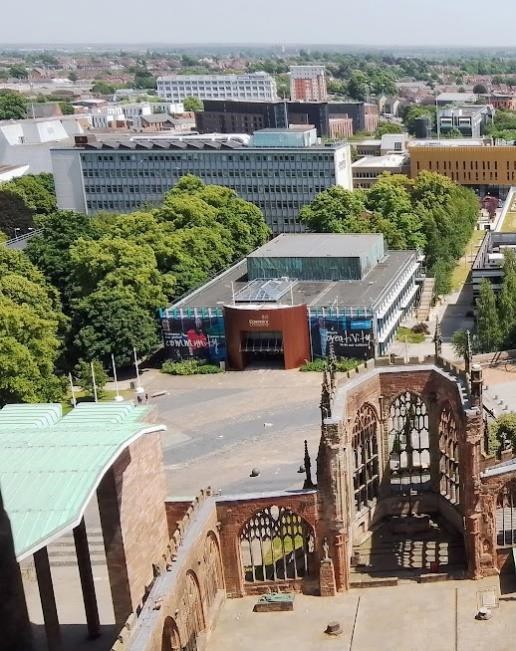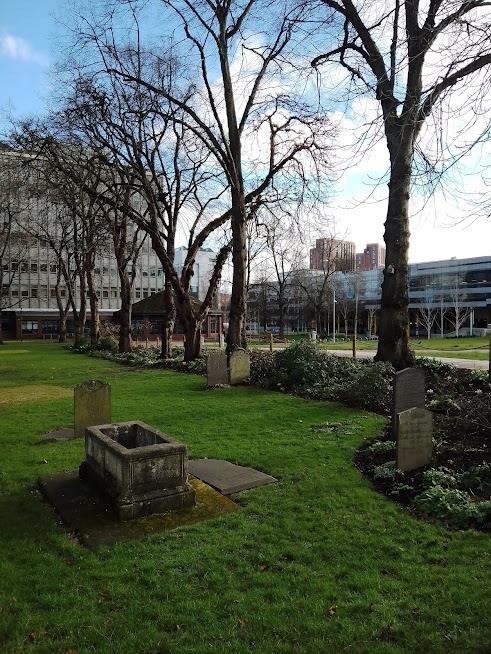John Marshall, CovSoc member and editor of Jabet’s Ash, the newsletter of the Stoke Local History Group, tells us the history of the site opposite the Cathedral on Priory Street.

A new sculpture by George Wagstaffe, situated opposite Coventry Cathedral, now takes pride of place in a newly reconfigured green corridor, stretching from University Square in Priory Street to the Delia Derbyshire Building in Cox Street.
The new green corridor has been made possible following the demolition of the old Alan Berry Building – originally known as F Block and completed in 1963 – which for many years was the main administration centre of the Lanchester College of Technology, later Lanchester Polytechnic and now Coventry University.
The university says the idea is to create a high-quality landscaped space, providing an uninterrupted view to Coventry Cathedral from its new Faculty of Arts and Humanities in Cox Street. It is the latest stage in the redevelopment of the university campus and follows the creation of Starley Gardens in Cox Street, which took the place of a former teaching block.

For those with an interest in history, the newly created green space provides us with an opportunity to take a fresh look at the amazing history of the area, which was once the site of a Bishop’s Palace, a garden, an orchard and a graveyard.
According to information provided by the university in 2016, the area has a long and varied history. It points out that Priory Street is a relatively modern road, only opened in 1856-57. Prior to this, the site was occupied by the Palace and Gardens of the Bishop of Coventry and Lichfield.
The palace was located on the grassy area just outside the east wall of the modern Cathedral, extending across what is now Priory Street to the current area of gardens and graves. Land was first given to Bishop Alexander de Stavenby for the Palace in 1224-5. Almost 60 years later his successor Bishop Roger de Meuland was given further land and £133 to repair and extend the existing palace.
The palace was a grand building consisting of a great hall for receiving guests and dining, sleeping apartments, kitchens, storage rooms, stables and gardens. The gardens were to the east, towards where the George Eliot Building now stands, and contained orchards, fishponds and a banqueting house.
The main building ceased to be a palace in 1539 when St Mary’s Cathedral was closed and demolished – the result of King Henry VIII’s Dissolution of the Monasteries – and the Bishop moved to his other residence in Lichfield. But the palace buildings and gardens remained.
By 1646 the palace buildings are known to have been sub-divided into different properties and by 1749 a map of Coventry shows only the Bishop’s orchard still here. These orchard gardens were given over to burials in 1793 when nearby St Michael’s churchyard was at full capacity. But this was a short-term arrangement as burials ceased in 1848, with the opening of London Road Cemetery.

During the 1960s the temporary burial ground was incorporated into Lanchester Polytechnic. During the creation of a new garden, says the university, a number of headstones were discovered. One belonged to the organist of St Michael’s from the early 19th century, whilst others sadly illuminated the very high mortality rates of children in Victorian times.
One family, the Worcesters, lost all three children in quick succession, each under the age of six months, whilst another mother had been laid to rest with her five children. Groups of large families, often sharing accommodation with insufficient rudimentary arrangements for human waste disposal, resulted in overcrowded slum conditions where streets became, effectively, open sewers. The poor living standards created the ideal breeding conditions for illnesses such as cholera, typhus and diarrhoea, exacerbating the number of deaths amongst the new born and young.
This article is reprinted from the February 2024 edition of Jabet’s Ash, the newsletter of the Stoke Local History Group with kind permission of the group. The article is based on information supplied by Coventry University. An information board can be seen on site.
